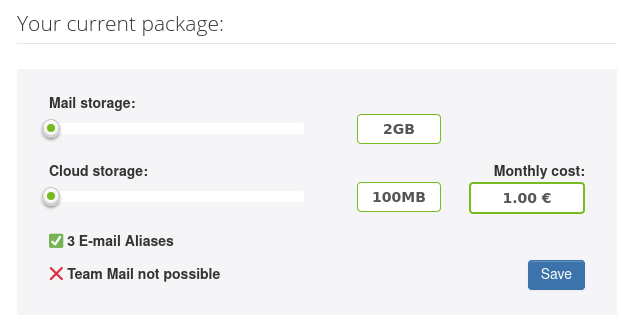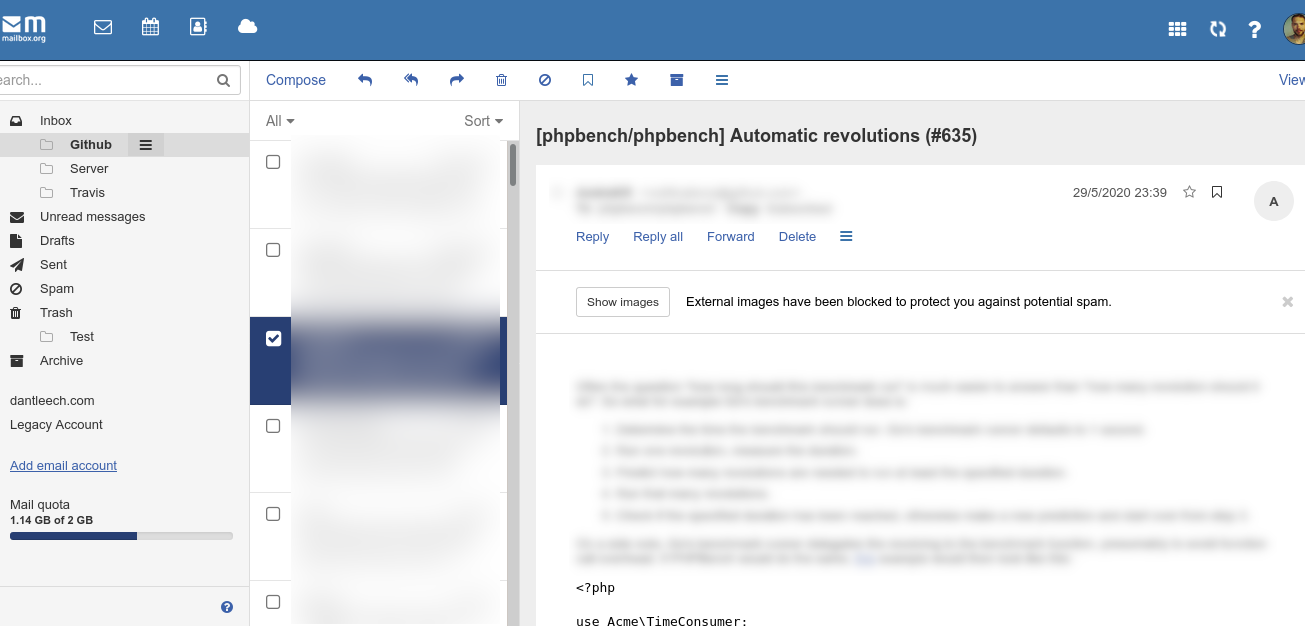Mailbox dot org
Last modified 2022/09/14 11:14I had been hosting my own email for several years. I started using Gmail in 2005 or so but the advertising really bugged me, so I thought I would host my own email - it also seemed like a cool project. But I learned that it’s not that easy.
Later I heard about sovereign which is an Ansible playbook to setup your own cloud. All you need to do is buy a dedicated server (I used a Scaleway Dedibox) and run Ansible to install and configure the software.
Sovreign sets up lots of services on your server - but in regards to email is installs Dovecot/Postfix server with storage on an encrypted mount, it also provided a roundcube web interface.
I never succeeded in getting mail filtering to work properly. I rarely received SPAM but I did receive unwanted notifications from my server which I deleted daily (!).
Upgrading Sovereign was a pain - as you basically fork the project in order to customize it, you would have to merge changes back in.
The truth is that you still need to know how all that software works in order to manage it - and as I am somebody who would spend several hours a year battling with this software - I didn’t understand it.
So I decided to look elsewhere.
Mailbox dot org ¶
After an in-exhaustive search for mail hosting options - and after seeing some recommendations on Twitter, I decided to try mailbox.
Probably the most important factor when considering mail hosting is privacy and security.
The company is based in Berlin and has a long history.
I gather that Germany has strong privacy laws, but not the strongest. Mailbox provide a transparent security report showing the number of information requests made by various entities.
Cost ¶
The initial account is free and a full account is €12 a year, but it’s also flexible and you can tune your storage requirements and price to your tastes.

You can make payments when ever you like and add credit to your account through the web interface.
Migration ¶
TL;DR; migrate mail in the web interface.
I needed to transfer around 1.2GB of mail from my mail server to mailbox.org.
My first approach was to use offlineimap to achieve this.
Offlineimap is normally used to sync data
from a mail server to your localhost. But by switching somethings around
you can restore mail to a
server.
This approach was going well until I noticed that all the mail in my mailbox.org account had a delivery date of today.
This issue was reported here and the advice was to not import via. IMAP.
Instead you should add your other account to the Mailbox account and “drag and drop” the mail from one account to another.
Unfortunately I had gotten excited and had removed Dovecot from my web server, fortunately it re-installed without an issue and I was able to attach my legacy account and transfer all the mail correctly.
Services ¶
The mailbox account provides mail, but it also provides some cloud storage (100MB), Calendar, an office suite and various other things.
I was initially a bit put-off by all the extras, but I discovered that you can disable them, and perhaps I may find some of them useful some day.
The cloud storage doesn’t provide much capacity by default and there is no option to sync data (you can mount it as a WebDAV drive though). For storage I will continue to use Syncthing on my web server (and laptops).
As a side-note, Syncthing is a decentralised solution (it will sync between two computers on a local network) and I can take advantage of my 1TB of storage I have on my ~€10 a month server).
User Interface ¶
I’ve found the user interface to be very good. You have a range of “views” for email: vertical (as above), list (gmail-like), horizontal and compact.

Double clicking on a mail opens a modal. All the modals can be managed like windows - you can drag, resize, dock and close them.
The configuration can be a bit overwhelming - and I had too google in order to find where the mail filters are configured. But there is lots to discover. You even have access to an error log.
Security ¶
Mailbox supports 2 factor authentication, and provides the option to easily encrypt / sign your emails from the web interface.
Own Domain ¶
Mailbox happily permits you to use your own domain and add email aliases.
I had to modify the DNS record of my domain as documented.
You can then use your domain as the primary email for your account (so I login
to mailbox using my email address, rather than the default [email protected]
address).
Consumption ¶
Nothing changed in the way I consume my mail outside of the web interface. I am using K9Mail (installed via Fdroid) on my Android phone, and I just reconfigured the Imap / SMTP settings.
Equally I can setup offlineimap to sync emails to my localhost and use
Neomutt as a mail client.
Summary ¶
So far very happy with it and am very glad not to manage my own mail server.